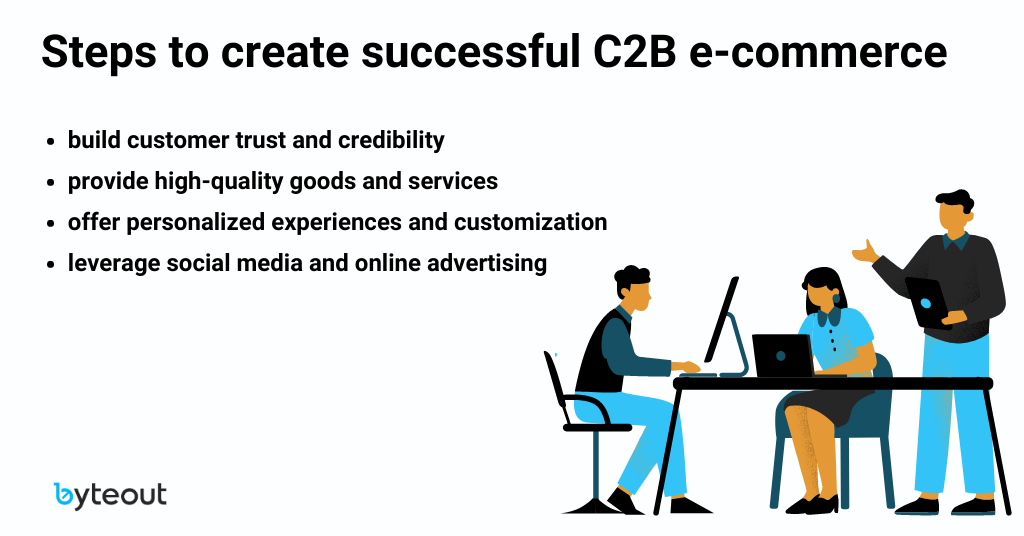C2B e-commerce, also called consumer-to-business, is a business model that stands as the complete opposite of the traditional B2C (business-to-consumer) approach. B2C works in the direction of business-to-consumer, where a company sells to individuals. In the C2B model, individuals provide products and services to businesses.
C2B e-commerce has grown increasingly and is very relevant in today’s market. It allows consumers to monetize their skills and assets. The C2B model helps create new revenue streams and opportunities for entrepreneurship. For example, someone with graphic design skills can offer their services to businesses looking for a new logo or website design locally and worldwide, thanks to the global reach of online platforms.
Upwork is one of the pioneering platforms in the C2B e-commerce model. Previously known as Elance, the platform enables businesses to hire talented freelance professionals worldwide to complete specific projects or tasks. Freelancers showcase their skills and experience; companies can post job listings and browse the available talent.
Upwork’s success has helped drive the growth of the C2B e-commerce model. The platform successfully connects businesses with talented professionals in a global marketplace.
Consumers are starting to realize their power and are looking to profit from it. As a brand leverages its reputation, customers can utilize their impacts similarly.
How does C2B e-commerce work? #
C2B e-commerce involves a digital platform that connects consumers with businesses. These platforms allow consumers to list their offerings, including details like pricing and specifications, providing a venue for businesses to find and engage with potential service providers or product suppliers. Recent developments have introduced AI-driven matchmaking features, improving the efficiency of connecting businesses with the precise services they need.
Here’s how C2B e-commerce works in general steps:
- Consumer offers a product or service. In C2B e-commerce, consumers act as suppliers by offering businesses products, services, or expertise. This can range from freelance services such as graphic design or content writing to selling handmade crafts or digital assets.
- Business needs the offered product or service. Businesses needing specific products or services will review listings or respond to bids and offers that match their requirements. They may also seek out individual freelancers or small businesses to fulfill their needs.
- Negotiation and agreement. Once a business finds a suitable offer, it may negotiate terms, pricing, and deadlines directly with the consumer. This negotiation process can occur through various channels.
- Transaction and payment. After reaching an agreement, the business and consumer proceed with the transaction. Depending on the agreement’s nature, payment may be made upfront, upon completion, or based on milestones.
- Delivery and completion. The consumer delivers the product or service to the business according to the agreed-upon terms. This may involve providing digital files, delivering physical goods, or completing the contracted service. Upon delivery and verification of satisfaction, the transaction is considered complete.
C2B and B2C differences #
Businesses operate under two primary models: consumer-to-business (C2B) and business-to-consumer (B2C). While they might seem similar at first glance, they cater to distinct audiences and have unique dynamics. Let’s examine the key differences between C2B and B2C to better understand how each model shapes the interaction between businesses and their customers.
The direction of the transaction #
In B2C e-commerce, the direction of the transaction is from business to consumer. In other words, companies create products or services and sell them to consumers. In C2B e-commerce, the direction of the transaction is from consumer to business. Consumers offer their products or services to businesses, who can purchase them.
Who is more powerful, business or consumer? #
B2C e-commerce involves businesses with greater power and resources selling to individual consumers. This creates a power imbalance, and companies have greater control over pricing, product features, and other aspects of the transaction.
However, in C2B e-commerce, consumers have greater power and control over the transaction. Consumers offer their products or services and set their pricing.
Sales and marketing approach #
In B2C e-commerce, businesses often use targeted marketing and advertising campaigns to reach a large consumer audience.
In C2B e-commerce, consumers market their products or services to businesses through online platforms and marketplaces.
C2B Advantages #
C2B e-commerce continues to grow because it offers advantages for both consumers and businesses. Here are some of the key benefits.
Lower prices for consumers #
C2B e-commerce can lower consumer prices, as businesses can access a wider pool of suppliers and service providers. This results in greater competition and lower costs. For example, a small business may hire a freelance graphic designer on a C2B platform for a lower price than a design agency would pay.
Increased competition among businesses #
C2B e-commerce can create a more level playing field for businesses, as smaller companies and individuals can directly offer their products and services to larger firms. This can increase competition and lead to better prices and quality for businesses.
Greater access for consumers #
C2B e-commerce platforms make accessing a more comprehensive range of products and services easier for consumers. Plus, they are often more fantastic and convenient than traditional retail channels. For example, a consumer can hire a personal trainer on a C2B platform without going to a gym.
Increased customization and personalization options #
C2B e-commerce allows businesses to access a broader range of skills and resources, leading to greater customization and personalization options for consumers. For example, a company can hire a freelance web developer to create a custom website that meets its needs.
Freelance websites like Upwork and Fiverr are popular in C2B e-commerce. These platforms allow businesses to hire freelance workers for specific projects or tasks, often on a per-project or per-hour basis.
C2B Disadvantages #
While C2B e-commerce has many advantages, businesses and consumers must also be aware of several challenges.
Lack of trust #
One major challenge is trust and reliability in online transactions. Consumers may hesitate to offer their products or services to businesses online, and they fear they will not receive payment or the transaction will not be completed as expected.
On the other hand, businesses may hesitate to purchase products or services from unknown individuals or entities.
Difficulty in managing quality control #
Another challenge is the difficulty of managing quality control for goods and services. Consumers offer specialized or unique products or services, and it must be challenging for businesses to ensure that these products or services meet their standards.
Negative consumer responses #
Businesses that rely on customer service are open to negative comments. Negative reviews can be a disadvantage for C2B e-commerce, as they can undermine trust and reliability.
Businesses may be hesitant to purchase products or services from individuals with a history of negative reviews.
However, C2B sellers can build trust and credibility by addressing negative feedback and improving the quality of their products or services.
C2B and C2C differences #
We covered cases where the buyer was a business. But what happens when your buyer is another consumer? In that case, we move to another model called consumer-to-consumer, which we cover in more depth in our C2C article.
How to succeed in C2B #
To succeed in C2B e-commerce, customers must gain businesses’ trust and credibility. This can be achieved by:
- providing high-quality goods and services,
- offering personalized experiences and customization options,
- leveraging social media and online advertising to reach customers.
Building trust and credibility with customers is essential in C2B e-commerce. It helps establish a positive reputation and encourages re-purchasing or re-hiring. Providing high-quality goods and services ensures that customers receive the value they expect.
Offering personalized experiences and customization options can help to differentiate a business from competitors and create a unique and memorable customer experience.
Leveraging social media and online advertising can help businesses to reach new customers and increase their visibility.

Examples of the C2B model #
There are many examples of C2B e-commerce platforms that are popular among businesses and consumers alike.
Marketplaces like eBay, Craigslist, and Amazon are great examples of the C2B model. These platforms allow consumers to sell products directly to businesses.
Stock photography websites like Shutterstock and Adobe Stock are where photographers upload their photos, allowing businesses to purchase the rights to use them in marketing campaigns or on their websites.
Other examples of C2B e-commerce platforms include crowdfunding platforms like Kickstarter and Indiegogo. Inventors or creators present their ideas or projects to the public, and businesses can back or fund these projects in exchange for early access to products or services.
For example, a consumer with a new invention can offer pre-orders of their product on Kickstarter. If they reach their funding goal, they can use the funds to produce and deliver the product to their customers. Indiegogo allows consumers to raise funds for their creative projects.
One of the key advantages of C2B is the ability for consumers to have more control. Some approaches offer unique opportunities for consumers to monetize their skills and interests:
- Reverse public auctions: allow customers to name their price for a product or service,
- Affiliate advertising: enables end-users to market certain items on a commission basis,
- Promotion room: enables end-users to obtain the clicks on various firms’ ads,
- Research data providers: provide feedback and valuable research data to companies.
Summary #
C2B e-commerce represents a significant shift in how businesses and consumers interact.
By allowing consumers to offer their products or services to businesses, C2B e-commerce provides a range of benefits. Some key benefits include lower prices, increased competition among companies, greater consumer access, and increased personalization.
There are always two sides to a story, so there are also challenges in C2B e-commerce. The C2B model may need more trust and help to manage quality control.
To succeed in C2B e-commerce, businesses must:
- build customer trust and credibility,
- offer goods and services of a high quality,
- provide personalized experiences and customization options,
- improve your social media presence and online advertising to reach customers.
Do you want to learn more about e-commerce? Continue reading about → Dynamic pricing.

